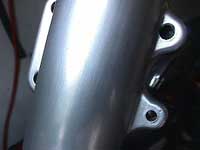
Maintenance
Fork Maintenance 
| Home | |
| Maintenance | |
| Riding Skills | |
Also, insurance companies are not very amiable towards riders who neglect their machines and, if this neglect is the cause of an accident and is proved, the insurance company are within their rights to cancel the policy and consequently land the rider with a hugh bill for damages. So, at the slighest hint of any malfunction in the suspension or steering it must be recified as soon as possible.
Routine maintenance is essential to ensure the correct function of the telescopic legs and to this end the correct amount recommended oil must be used. Most manufactures stipulate a set milage or period of time, the arrival of which indicates that the oil must be changed or the level checked.
Machines fitted with a drain plug at the bottom of the forks can be drained easily, but the older type of fork can only be drained by inverting them when removed from the machine, preferably at a time of major overhaul. To refill the forks, undo and remove the top fork leg nuts and empty yhe oil into the leg. Ensure that the correct amount of oil is measured by pouring into a calibrated measuring jug or syringe.
Undoing the bolt on the lower yolk to remove the stanchions.
Machines which judder under braking or "roll" on conering, indicate that either the fork bushes or the tubes are worn or the steering head bearings require adjustment or renewing. Standing alongside the motorcycle with the front brake held on and pushing the bike back and forth will isolate the fault. Looking closely at the bearing housing and the yoke and watching for movement whilst carring out this test, will show if adjustment is needed. Continueing to rock the machine back and forth and looking at that part of the forks where the slider fits into the tube and watching for bending, will indicate whether or not new bushes are required.
To adjust the steering head bearings, there is normally a large nut located on top of the yoke. A certain amound of care is required when adjusting the steering head bearings to avoid overtightening which will cause rolling zt slow speeds. The nut should just take up all the free play in the head bearings and this can be checked by pushing and pulling on the fork ends. If, after adjusting the steering, the steering is still stiff and on listening to the bearings they emit a noisy grating sound, it may be that the steering head will require dismantling and a closer examination of the bearing cups and ball bearings made necessary. Once the yoke has been removed, the bvearing cups should be ecamined for signs of pitting and, if evident, driven from the frame unit with the aid of a soft metal drift and the new ones tapped in. The new cups should be fitted squarely otherwise the steering will develop tight spots and quickly wear out the new bearings. Cups and bearings should always be renewed together; never fit new bearings to worn cups. To aid reassembly, use a grease to hold the ball bearings in position until the adjusting nut can be fitted and tightened. A space equal to one ball bearing should be left in each cup in order to prevent ball bearings binding, and an equal number of ball bearings should be fitted to each of the top and bottom races. Upon reassembly of the steering yoke, readjust the bearings and wipe away any excess grease.
The fork stanchions exposed.
Juddering under braking conditions which cannot be contributed to faulty steering head bearings may indicate that the front forks will require removal and dismantling and the top and bottom bushes rebewed. Forks which have been damaged, ie twisted in an accident, will cause the machine to wobble at speed and must be renewed. One of the more common faults with fork legs is fluid leakage from the top oil seal and this should be renewed as soon as possible otherwise the handling will slowly deteriotate as the oil level drops. The fork removal procedure differs from machine to machine but normally involves removing the headlamp, various cables and wiring connections and mudguard, and undoing the clamp bolts and pulling the complete leg clear. Once the fork is completely dismantled, a close examination of the leg and stanchions to determine wear and scoring or excessive play is necessary. If excessive, the complete leg should be renewed, if no bushes are used in its construction.
Upper steering ball race undone for inspection and maintenance
Springs should be checked for free length measurement against the specification of the machine and all oil seals and gaiters renewed. Before reassembly begins, the stanchions or tubes and legs should be checked for accident damage and renewed if evident. Once all the components have been checked and renewed where necessary, reassembly can begin. Everything must must be cleasn and free from burrs. As each component is replaced, it should be lubricated with oil or grease. When refitting gaiters (if fitted) ensure that the air bleed hole is correctly positioned, normally at the bottom. When the fork legs have been refitted to the yoke, the steering head bearing adjustment must be checked and all the ancillary equipment replaced. Top up the forks with the correct amount of recommended fluid before replacing the leg top nuts.
Removal from machine will produce the best working conditions
All the components which are assembled into motorcycle forks.
It requires very little effort from the enthusiast to keep his machine in good working order and it is he who will derive the most pleasure, from not only being safe with the knowledge that his machine is up to scratch but also, that the machine is giving its best in terms of performance and roadholding.
www.vjmw.org
The Garage -- Fork Maintenance